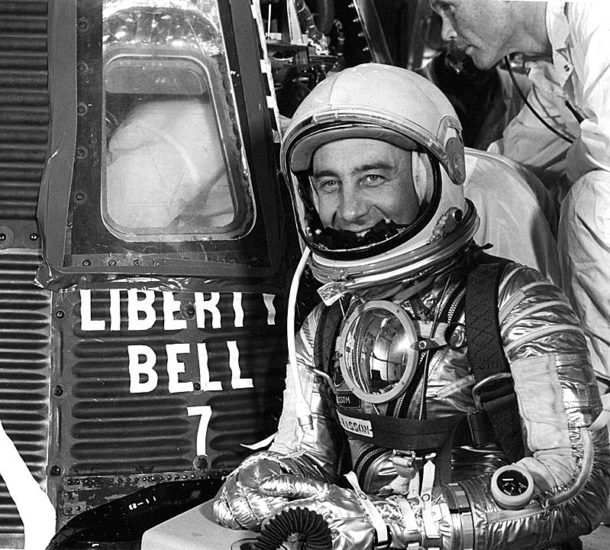
Fifty-seven years ago this month, Mercury Seven Astronaut Vigil I. “Gus” Grissom, Jr. became the second American to go into space. Grissom’s suborbital mission was flown aboard a Mercury space capsule that he named Liberty Bell 7.
The United States first manned space mission was flown on Friday, 05 May 1961. On that day, NASA Astronaut Alan B. Shepard, Jr. flew a 15-minute suborbital mission down the Eastern Test Range in his Freedom 7 Mercury spacecraft. Known as Mercury-Redstone 3, Shepard’s mission was entirely successful and served to ignite the American public’s interest in manned spaceflight.
Shepard was boosted into space via a single stage Redstone rocket. This vehicle was originally designed as an Intermediate-Range ballistic Missile (IRBM) by the United States Army. It was man-rated (that is, made safer and more reliable) by NASA for the Mercury suborbital mission. A descendant of the German V-2 missile, the Redstone produced 78,000 lbs of sea level thrust.
Shepard’s suborbital trajectory resulted in an apogee of 101 nautical miles (nm). With a burnout velocity of 7,541 ft/sec, Freedom 7 splashed-down in the Atlantic Ocean 263 nm downrange of its LC-5 launch site at Cape Canaveral, Florida. Shepard endured a maximum deceleration of 11 g’s during the reentry phase of the flight.
Mercury-Redstone 4 was intended as a second and confirming test of the Mercury spacecraft’s space-worthiness. If successful, this mission would clear the way for pursuit and achievement of the Mercury Program’s true goal which was Earth-orbital flight. All of this rested on the shoulders of Gus Grissom as he prepared to be blasted into space.
Grissom’s Liberty Bell 7 spacecraft was a better ship than Shepard’s steed from several standpoints. Liberty Bell 7 was configured with a large centerline window rather than the two small viewing ports featured on Freedom 7. The vehicle’s manual flight controls included a new rate stabilization system. Grissom’s spacecraft also incorporated a new explosive hatch that made for easier release of this key piece of hardware.
Mercury-Redstone 4 (MR-4) was launched from LC-5 at Cape Canaveral on Friday, 21 July 1961. Lift-off time was 12:20:36 UTC. From a trajectory standpoint, Grissom’s flight was virtually the same as Shepard’s. He found the manual 3-axis flight controls to be rather sluggish. Spacecraft control was much improved when the new rate stabilization system was switched-on. The time for retro-fire came quickly. Grissom invoked the retro-fire sequence and Liberty Bell 7 headed back to Earth.
Liberty Bell 7’s reentry into the Earth’s atmosphere was conducted in a successful manner. The drogue came out at 21,000 feet to stabilize the spacecraft. Main parachute deployed occurred at 12,300 feet. With a touchdown velocity of 28 ft/sec, Grissom’s spacecraft splashed-down in the Atlantic Ocean 15 minutes and 32 seconds after lift-off. America now had both a second spaceman and a second successful space mission under its belt.
Following splashdown, Grissom logged final switch settings in the spacecraft, stowed equipment and prepared for recovery as several Marine helicopters hovered nearby. As he did so, the craft’s new explosive hatch suddenly blew for no apparent reason. Water started to fill the cockpit and the surprised astronaut exited the spacecraft as quickly as possible.
Grissom found himself outside his psacecraft and in the water. He was horrfied to see that Liberty Bell 7 was in imminent peril of sinking. The primary helicopter made a valiant effort to hoist the spacecraft out of the water, but the load was too much for it. Faced with losing his vehicle and crew, the pilot elected to release Liberty Bell 7 and abandon it to a watery grave.
Meanwhile, Grissom struggled just to stay afloat in the churning ocean. The prop blast from the recovery helicopters made the going even tougher. Finally, Grissom was able to retrieve and get himself into a recovery sling provided by one of the helicopters. He was hoisted aboard and subsequently delivered safely to the USS Randolph.
In the aftermath of Mercury-Redstone 4, accusations swirled around Grissom that he had either intentionally or accidently hit the detonation plunger that activated the explosive hatch. Always the experts on everything, especially those things of which they have little comprehension, the root weevils of the press insinuated that Grissom must have panicked. Grissom steadfastly asserted to the day that he passed from this earthly scene that he did no such thing.
Liberty Bell 7 rested at a depth of 15,000 feet below the surface of the Atlantic Ocean until it was recovered by a private enterprise on Tuesday, 20 July 1999; a day short of the 38th anniversary of Gus Grissom’s MR-4 flight. The beneficiary of a major restoration effort, Liberty Bell 7 is now on display at the Kansas Cosmosphere and Space Center. The spacecraft’s explosive hatch was never found.
As for Gus Grissom, ultimate vindication of his character and competence came in the form of his being named by NASA as Commander for the first flights of Gemini and Apollo. Indeed, Grissom and rookie astronaut John W. Young successfully made the first manned Gemini flight in March of 1965 during Gemini-Titan 3. Later, Grissom, Edward H. White II and Roger B. Chaffee trained as the crew of Apollo 1 which was slated to fly in early 1967. History records that their lives were cut short in the tragic and infamous Apollo 1 Spacecraft Fire of Friday, 27 January 1967.

